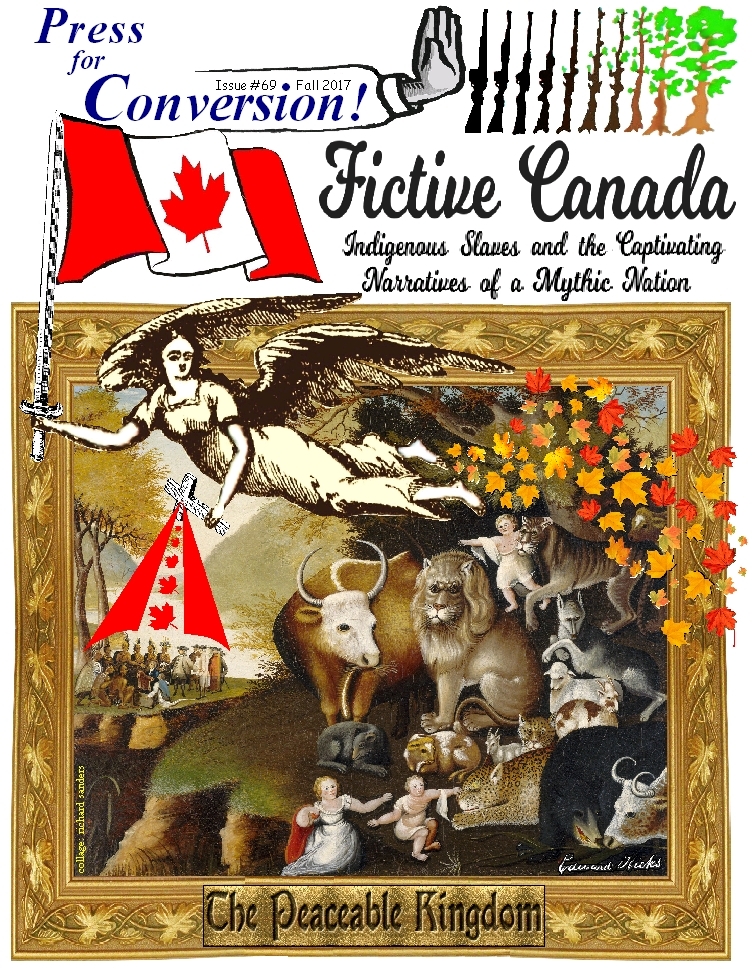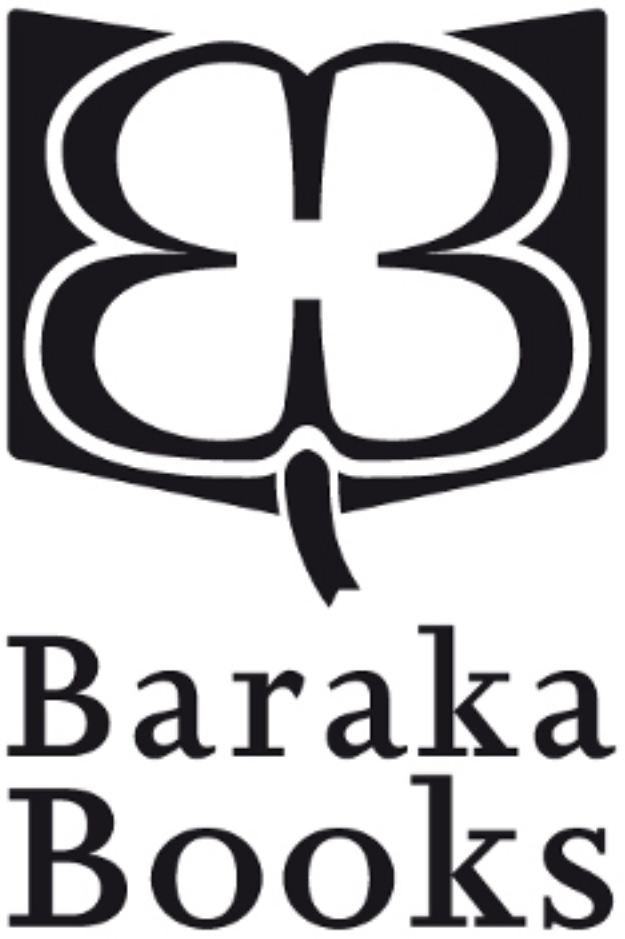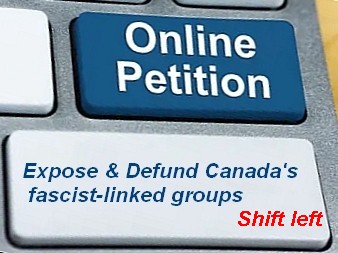|
(1)
Germany’s Ukrainian Central Committee (UCC)

Ukrainian Central Committee
president Volodymyr Kubijovych (left) lead Ukrainian collaboration with the
Nazis during WWII. In this photo he is with Hans Frank, the Nazi governor
of occupied Poland.
 Frank, aka "the Butcher of Poland," was executed at Nuremberg in 1946.
Kubijovych succeeded in getting the Nazis to create a special SS division for
Ukrainians, the Waffen SS Galicia. Its symbol was a rampant lion
surrounded by three crowns, in the colours of Ukraine, i.e., blue and yellow. Frank, aka "the Butcher of Poland," was executed at Nuremberg in 1946.
Kubijovych succeeded in getting the Nazis to create a special SS division for
Ukrainians, the Waffen SS Galicia. Its symbol was a rampant lion
surrounded by three crowns, in the colours of Ukraine, i.e., blue and yellow.
ProNazi newspapers were produced by the UCC's Ukrainian Publishing
House, of which Kubijovych was also president. Those newspapers, edited and
managed by Michael
Chomiak, printed edited speeches by Adolph Hitler and his henchmen, promoted Nazi news and recruited for the Waffen SS Galicia.
After WWII, Kubijovych was fixated on creating
The
Encyclopedia of Ukraine. Since his 1976 visit to Canada, the encyclopedia
has been a project of the Canadian Institute for Ukrainian Studies, at the University
of Alberta, in Edmonton. Both Nazi-propagandist Chomiak and his granddaughter
Chrystia Freeland, worked on Kubijovych's encyclopedia.

|

Volodymyr Kubijovych on the podium with Nazi military leaders to salute
their creation of the Ukrainian Waffen SS. Kubijovych was boss to the
Nazi's top Ukrainian-language propagandist, Michael Chomiak, grandfather
of Chrystia Freeland. |
While millions of Jews, Poles and communists faced imminent genocide, the Nazis
created a huge renaissance for Ukrainian nationalists. Thousands of émigrés, who
had fled Soviet Ukraine, happily received homes, schools, businesses and other
properties and possessions stolen by the Nazis from Polish Jews. The Ukrainians
who profited from the Aryanisation/dejewification of Poland included Michael
Chomiak, the maternal grandfather of Canada’s current deputy prime minister,
Chrystia Freeland. His publishing office, printing presses, two apartments and
their furnishings were all stolen from Polish Jews.1
Uniting these émigrés was the Ukrainian
Central Committee (UCC). It represented the Melnyk faction of the fascist,
antisemitic, antiSoviet Organisation of Ukrainian Nationalists (OUN) which aided
Germany throughout the war. When UCC president, Volodymyr Kubijovych, "the most
senior Ukrainian collaborator with Nazi Germany,"2 urged Germany to create a
Ukrainian unit to fight the Soviets, the Waffen SS Galicia was born. It
recruited through the Nazis, the Ukrainian churches (Orthodox and Catholic) and
UCC papers edited by Chomiak.
|

The Ukrainian Central
Committee
was created in 1940 by the
Nazi's military intelligence agency,
the Abwehr, and managed by
Colonel Alfred Bisanz. |
Thanks to Nazi largesse, the UCC printed
millions of papers, magazines and books. Working under Kubijovych, Chomiak was
the UCC’s chief news editor and oversaw Nazi propaganda. After WWII, Kubijovych
began The Encyclopedia of Ukraine to rewrite nationalist history.
In 1976, Kubijovych went to Edmonton to sign a deal with the Canadian Institute
of Ukrainian Studies at the University of
Alberta to copublish his encyclopedia. Both Chomiak and Freeland worked on
Kubijovych’s propaganda effort.
During WWII, the Nazis controlled the UCC. It
was housed in "a shared building" in Krakow, says Polish historian Pawel
Markiewicz: "The Ukrainians were headquartered there as well as the German
military intelligence or Abwehr."3
When Nazi Colonel Alfred Bisanz was arrested at
war’s end, he described the UCC’s utter subservience to its Abwehr masters:
"Kubijovych’s UCC was created by the Abwehr
in Krakow in 1940. From the first day of its existence, it was directly
supervised by ... the Second Department of the Abwehrstelle-Krakow ....
As an assistant to the head of the Department, I was charged with directing
UCC activity. Without the Abwehrstelle’s permission and my personal clearance,
Kubijovych had no right to include any person in the Committee or take any
action.... [F]inancing the UCC was also carried out through me. Each month
throughout 1940, I personally handed Kubijovych and UCC Sec.-General
Hlibovitsky a sum of 50-60 thousand zlotys."4 (Emphasis added.)
|
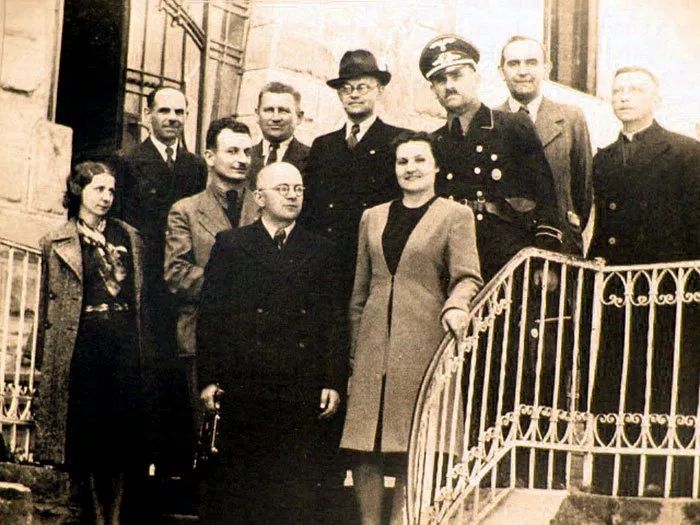
Nazi Colonel Alfred Bisanz poses with
Volodomyr Kubijovych
and other members of his Ukrainian Central Committee |
The Abwehrstelle-Krakow was Abwehr HQ for
occupied Poland. The UCC, being an asset of Abwehr’s "Second Department," was
responsible for "sabotage," particularly the "direction of covert contacts" and
"exploitation of discontented minority groups in foreign countries for
intelligence purposes."5
It also created two Nazi-trained, -armed and
-led Ukrainian battalions (Roland and Nachtigall), which were set up by Stepan
Bandera’s faction of the OUN. The latter battalion’s Ukrainian commander, war
criminal Roman Shukhevych, is glorified as a freedom-fighting hero by
Bandera-revering émigré groups that
are among the fascist-rooted groups that receive
generous funding from
Canada’s government.
References
1. Richard Sanders, "Aryanisation and the
‘Mighty Wurlitzer,’" The Chomiak-Freeland Connection, Mar. 2017.
http://bit.ly/FreeChom8
2. Tarik Cyril Amar and Per Anders Rudling,
"What Standards Should be Applied when Deciding to Accept Funds?" April 15,
2015. http://bit.ly/Kubijovych
3. Personal email communication from Pawel
Markiewicz with author, March 8, 2017.
4. Klym Dmytruk, "Who are the ‘Diviziynyks,’"
Their True Face, Pt.4, 1979, pp.16-17.
http://bit.ly/BisanzUCC
(This would equal $3 to $3.6 million/year
in 2020.)
5. Abwehr, The Crypto Museum
http://bit.ly/AbwehrUCC
(2) Canada's Ukrainian
Canadian Committee (UCC)
|

The Ukrainian
Canadian Committee (UCC) was created in 1940 by the Canadian government.
It remains a heavily-funded, close working ally
of the Canadian government. |
In 1940, Mackenzie King’s Liberal government
created the Ukrainian Canadian Committee (UCC). This alliance, claiming to speak
for all Ukrainian émigrés, was an explicitly anticommunist front intent on
squashing leftist groups then dominating the diaspora. Renamed the Ukrainian
Canadian Congress in 1989, it unites businesses, credit unions, churches and
associations of veterans, women, youth, the arts and education.
Immediately after WWII, 40,000 Ukrainian
émigrés with extreme Russophobic/antiSoviet biases, boosted the UCC and its
member groups. They also brought the internal conflicts of the Organisation of
Ukrainian Nationalists (OUN). Formed in Vienna in 1929 by fascist Ukrainian
groups, it engaged in assassinations against Polish and Soviet officials.
Although united by eugenics, Christian antisemitism and toxic anticommunism, the
OUN split apart in 1941. This rift is still seen in within the UCC.
Bandera’s OUN(B) and the
League of Ukrainian Canadians (LUC)

Monument to
Stepan Bandera
Lviv, Ukraine |
The strongest faction, led by Stepan Bandera
(the OUN-B), worked with the Nazis until 1941 when they dared to declare an
"independent" fascist Ukrainian state. Their close support for the Nazis began
again in 1943, when they formed what became the
Anti-Bolshevik Bloc of Nations. Banderites, led in Canada by the
League of Ukrainian Canadians
(LUC), have dominated UCC leadership for decades. One LUC affiliate, the
Ukrainian Youth Association (UYA), like scouting outfits across the former
British empire, is structured along military lines. LUC’s Bandera youth
wear army-style uniforms, march in formation with WWII battle flags and venerate
such leaders of the OUN(B) and its Ukrainian Insurgent Army (UPA) as Bandera,
Yaroslav Stetsko and
Roman Shukhevych.
 Ukrainian
Insurgent Army (UPA) Ukrainian
Insurgent Army (UPA)
 The group representing UPA vets in Canada was also
deeply engaged in the UCC. In 2010, when Ukraine’s proNATO president declared
UPA vets as "Heroes of Ukraine," he was praised by then-UCC president
Paul Grod. Grod, a former UYA leader, then called on Canada’s government to change
the law so that UPA vets who were still alive in Canada could receive military
benefits. ( See list of
"National Members (Ukrainian Organizations)" from UCC
website, below.) The group representing UPA vets in Canada was also
deeply engaged in the UCC. In 2010, when Ukraine’s proNATO president declared
UPA vets as "Heroes of Ukraine," he was praised by then-UCC president
Paul Grod. Grod, a former UYA leader, then called on Canada’s government to change
the law so that UPA vets who were still alive in Canada could receive military
benefits. ( See list of
"National Members (Ukrainian Organizations)" from UCC
website, below.)
Melnyk’s OUN(M) and the
Ukrainian National Federation (UNF)
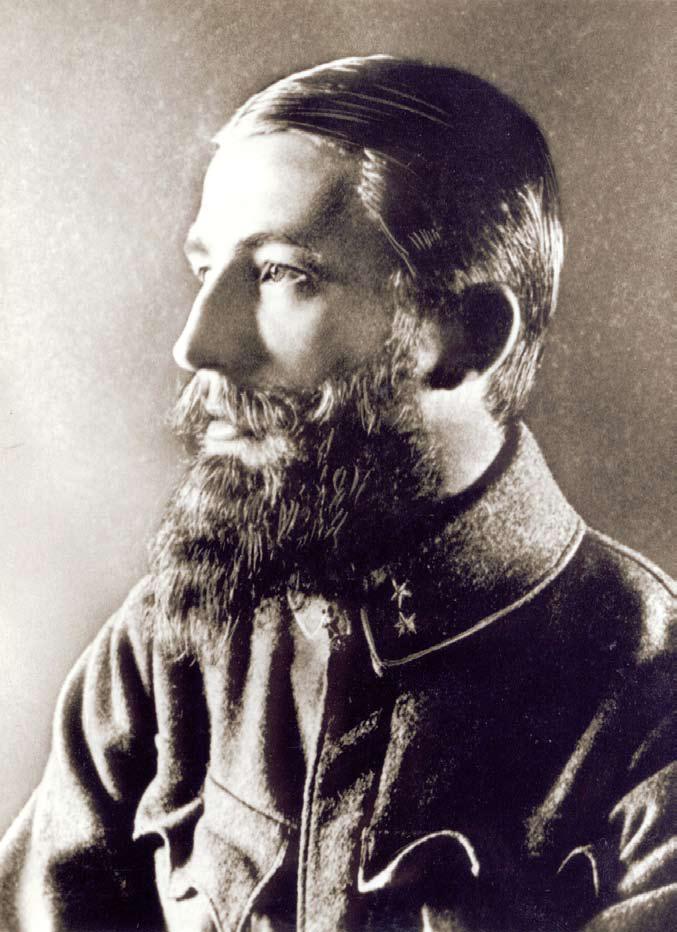 The OUN(M) faction, led by Andriy Melnyk, was
associated with the Ukrainian Central Committee. It led Ukrainian collaboration
with the Nazis during WWII. Deputy PM Chrystia Freeland’s maternal grandfather,
Michael Chomiak, was the chief editor and office manager for this Committee’s
proNazi newspapers. This OUN(M) heritage is represented in Canada by the
Ukrainian National Federation (UNF) of Canada which was pivotal in creating the
UCC. The UNF was founded, says its website, by OUN figures whose "influences and
vision remain a vital part of the organization to this day." The OUN(M) faction, led by Andriy Melnyk, was
associated with the Ukrainian Central Committee. It led Ukrainian collaboration
with the Nazis during WWII. Deputy PM Chrystia Freeland’s maternal grandfather,
Michael Chomiak, was the chief editor and office manager for this Committee’s
proNazi newspapers. This OUN(M) heritage is represented in Canada by the
Ukrainian National Federation (UNF) of Canada which was pivotal in creating the
UCC. The UNF was founded, says its website, by OUN figures whose "influences and
vision remain a vital part of the organization to this day."
The UNF has had long, close organizational ties with veterans' association of
the Nazi's Waffen SS Galicia in Canada. For example, in 1982, at its 27th
national convention in Edmonton, Mychajlo Romach was elected president of the
UNF presidium and its national executive board. Romach was also a leader of the
Ukrainian SS veterans' association in Canada. (See below.)
 14th Division Waffen SS Galicia 14th Division Waffen SS Galicia
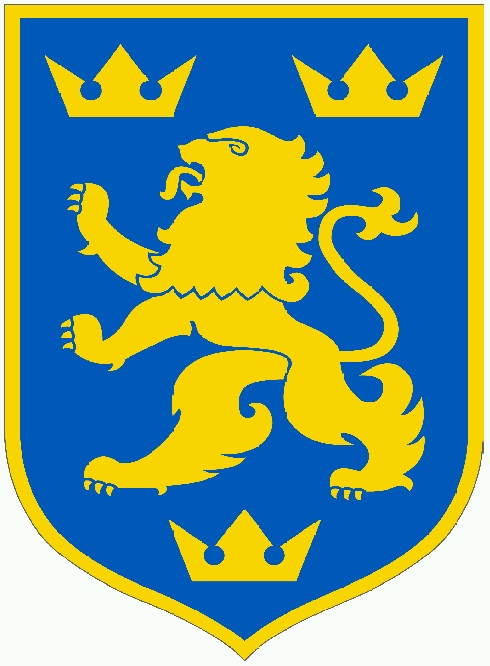 Formed in 1943, this division was created,
trained, armed, funded and led by the Nazis. Its volunteers, who swore an oath
to fight to the death for Adolph Hitler, battled the USSR’s Red Army and fought
partisans in Ukraine, Slovakia, Yugoslavia and Austria. Recruitment was done by
Nazi Germany, the Ukrainian churches (both Catholic and Orthodox) and the Ukrainian
Central Committee. Its papers, edited by Michael Chomiak, told Ukrainians that it was their
duty to enlist. Formed in 1943, this division was created,
trained, armed, funded and led by the Nazis. Its volunteers, who swore an oath
to fight to the death for Adolph Hitler, battled the USSR’s Red Army and fought
partisans in Ukraine, Slovakia, Yugoslavia and Austria. Recruitment was done by
Nazi Germany, the Ukrainian churches (both Catholic and Orthodox) and the Ukrainian
Central Committee. Its papers, edited by Michael Chomiak, told Ukrainians that it was their
duty to enlist.
Proud of these SS veterans in Canada and those of Bandera’s UPA,
their associations were listed as member groups on the UCC website until
mid-2016. See list of
"National Members (Ukrainian Organizations)" from UCC
website, left.
The Waffen SS Galicia veterans
association is deceptively listed as the "Brotherhood of Veterans 1st Division UNA [Ukrainian National Army] National HQ."
(The name "1st Division UNA" was
only adopted about one week before the end of WWII when it was obvious that the
Nazis were about to lose.)
|

Photo
source (ProWaffen SS) |
A mass, led by Ukrainian
Catholic Bishop
Josephat Kotsylovsky
blessed the Nazi's Waffen SS Galicia troops, on July 4, 1943. |
On July 10, 1941, Ukrainian Catholic Bishop
Josephat Kotsylovsky
welcomed Germany's Wehrmacht forces when they
invaded and occupied Przemyśl, in southern Poland.
When the Nazi's military intelligence agency, the Abwehr, decided to create,
fund, arm, train and lead the 14th Waffen SS Galicia, various Ukrainian forces
began calling for volunteers. Leading this call to join were Melnyk's faction of
the Organization of Ukrainian Nationalists (OUN-M), the Ukrainian Central
Committee and the Ukrainian Catholic
church. On July 4, 1943, Bishop Kotsylovsky led a mass to
bless the Ukrainian volunteers who joined the Nazis and vowed a religious oath
to fight to the death for Adolph Hitler, in cause of fighting communism.
|
 
Wasyl Kushnir
Longtime leader of the UCB and the UCC
“Let our culture be national rather than serve the
international Jew.”
Thus preached Kushnir at the First Ukrainian Catholic Workers’
Congress in 1937. (Source) |
Ukrainian Catholic Brotherhood (UCB)
The longtime leader of this key UNF member
group was Father Wasyl Kushnir who promoted antisemitic beliefs in the 1930s. In 1940,
he became the first UCC president and filled that post for most of its next
thirty
years (1940-53 and 1959-71).
Soon after WWII, Kushnir led UCC efforts to aid
Canada's
Liberal government in bringing about 40,000 antiSoviet Ukrainian émigrés to
Canada. Kushnir was especially keen to promote and assist the official effort to
welcome about 2,000 veterans of the Nazi’s Waffen SS Galicia.
For more information on the historic, far-right ideologies (including the
antisemitic and antcommunist roots) of Father Kushnir, the UCB and the UNF, see
this article:
Richard Sanders, "Left-Right
Camps:
A Century of Ukrainian Canadian Internment,"
Captive Canada,
Press for Conversion (Spring 2016), pp.40-55. (See
the section called "Ukrainian Right Saluted Nazism.")
Government funding
The Public Accounts of Canada show that
far-right Ukrainian groups receive millions in government grants. For example,
Ukrainian Canadian Congress(UCC)-Toronto has received $10.2 million to run language programs since 1995. In
addition, UCC HQ received $300,000 while its local chapters and provincial councils
(Alberta, Manitoba and Saskatchewan) received $145,000 since 2008.
During that same period, $983,000 was
dispersed to ultranationalist Ukrainian groups for mass public events in
Ontario, Alberta and Manitoba. The largest of these, the
UCC’s Toronto festival,
which promoted far-right Ukrainian groups, received $667,000.
Major UCC member groups also benefit. For
example, the Ukrainian National Federation (UNF) of Canada received $141,000 (2012-19) and the Ukrainian Women’s Association of Canada
(an Orthodox affiliate of the World Ukrainian Congress) got $58,000 (2015-19).
Banderite fronts like
League of Ukrainian Canadians
(LUC), through its Ukrainian Echo publication, and its women’s group (LUCW),
received
$114,000 (2010-19) while its Ukrainian Youth Association (UYA) received $141,000 (2015-19).
Cultural centres of the
LUC, UPA and UYA got grants for repairs in Winnipeg ($47,000 in 2013) and
Edmonton ($279,000 in 2015).
In 2008, the UCC-created Shevchenko
Foundation (SF) received $10 million to memorialize Canada’s internment of
Ukrainians during the WWI/Red-Scare era (1914-20). Claiming this was based
solely on ethnicity, SF ignores the fact that Canada targeted single, young,
laid-off, urban, male Ukrainians whose protests were feared might spark a
leftwing revolution. (See Richard Sanders, "Rendered Captive by Barbed Wire and
Maple Leaves." Captive Canada, Press for Conversion! #68. http://bit.ly/CapCda)
Provincial governments also give generously.
For example, the Public Accounts of Saskatchewan record that its government gave $1.6
million to the UCC (2007-16) plus $587,000 to UCC-Saskatchewan, $335,000 to UCC-Regina
and $1 million to UCC-Saskatoon (2013-19).
Since 2008, the leftwing Association of
United Ukrainian Canadians received one federal grant of only $5,500.
Here are other
articles in this issue
of Press for Conversion!
that refer to the Canadian government's financial support
for East European émigré groups with deep fascist roots
The Black Ribbon Day campaign:
Canada’s top Cold War propaganda export
Ongoing propaganda:
Canada’s
anticommunism monument and Magnitsky laws
Canada’s Ukrainian Canadian Congress
State-funded centres of Canada’s Bandera cult
& its Bandera youth
Roman Shukhevych:
Assassin, terrorist, war criminal and cult hero
Getting them young:
Instilling Ukrainian patriotism in children and youth
Chrystia Freeland: "Accidental journalist" or
groomed for the job?
Myron Kuropas: Downplaying Holocaust; Exaggerating Holodomor
Turning from same page: Freeland wrote for two profascist
publications
|




 Frank, aka "the Butcher of Poland," was executed at Nuremberg in 1946.
Kubijovych succeeded in getting the Nazis to create a special SS division for
Ukrainians, the Waffen SS Galicia. Its symbol was a rampant lion
surrounded by three crowns, in the colours of Ukraine, i.e., blue and yellow.
Frank, aka "the Butcher of Poland," was executed at Nuremberg in 1946.
Kubijovych succeeded in getting the Nazis to create a special SS division for
Ukrainians, the Waffen SS Galicia. Its symbol was a rampant lion
surrounded by three crowns, in the colours of Ukraine, i.e., blue and yellow.





 Ukrainian
Insurgent Army (UPA)
Ukrainian
Insurgent Army (UPA) The group representing UPA vets in Canada was also
deeply engaged in the UCC. In 2010, when Ukraine’s proNATO president declared
UPA vets as "Heroes of Ukraine," he was praised by then-UCC president
Paul Grod. Grod, a former UYA leader, then called on Canada’s government to change
the law so that UPA vets who were still alive in Canada could receive military
benefits. ( See list of
The group representing UPA vets in Canada was also
deeply engaged in the UCC. In 2010, when Ukraine’s proNATO president declared
UPA vets as "Heroes of Ukraine," he was praised by then-UCC president
Paul Grod. Grod, a former UYA leader, then called on Canada’s government to change
the law so that UPA vets who were still alive in Canada could receive military
benefits. ( See list of

 Formed in 1943, this division was created,
trained, armed, funded and led by the Nazis. Its volunteers, who swore an oath
to fight to the death for Adolph Hitler, battled the USSR’s Red Army and fought
partisans in Ukraine, Slovakia, Yugoslavia and Austria. Recruitment was done by
Nazi Germany, the Ukrainian churches (both Catholic and Orthodox) and the Ukrainian
Central Committee. Its papers, edited by Michael Chomiak, told Ukrainians that it was their
duty to enlist.
Formed in 1943, this division was created,
trained, armed, funded and led by the Nazis. Its volunteers, who swore an oath
to fight to the death for Adolph Hitler, battled the USSR’s Red Army and fought
partisans in Ukraine, Slovakia, Yugoslavia and Austria. Recruitment was done by
Nazi Germany, the Ukrainian churches (both Catholic and Orthodox) and the Ukrainian
Central Committee. Its papers, edited by Michael Chomiak, told Ukrainians that it was their
duty to enlist.



